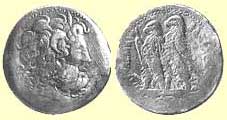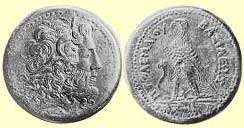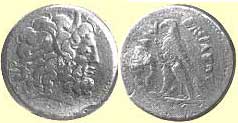
Two Eagles on Ptolemaic Coins as Representations of Co-Regency |
||||||||
|
|
||||||||
Part 1 - Bronze denominations of Ptolemy II A unique combination of obverse and reverse types can be identified for each of six (but not eight) denominations of Ptolemy II's bronze coins. However, as pointed out in Part 1, this does not mean that there was a policy to systematically modify various details of obverses or reverses in order to denote denominations. Part 1a - Denominations of Ptolemy III The question "Are there denominational indicators on the coins of Ptolemy III?" is considered in Part 1a. The conclusion is that denominational marking did not occur in the production of coins of Ptolemy III; it is very unlikely that it occurred
with coins of Ptolemy II. Part 1b - Hoard data of Ptolemies II, III, and IV Part 1b reviews the largest denomination that was produced by each of Ptolemies II, III, and IV.
As illustrated by the images shown above, only Ptolemy II produced the c.68g denomination with a two-eagle reverse type. Ptolemies III and IV produced the same denomination with the conventional one eagle. The conclusion is that, since these coins all have the same basic modular weight (i.e., same value), their different types (with one- and two-eagles) do not act as denominational indicators of different values. The two eagles were placed on coins of Ptolemy II not to show a denominational difference but for some other reason (see Part 2) that did not apply to coins produced by Ptolemy III and Ptolemy IV. Part 1c - Denominations of Ptolemy VI Ptolemy VI produced several different denominations all with a two-eagle reverse type. (Click here). Since all these various denominations have two-eagle reverses no single denomination is indicated by the presence of two eagles. Thus the two eagles on these denominations (that vary greatly in weight and size) cannot indicate a double denomination. Contrary to Price's suggestion that the two eagles on one of these denominations (Sv1424) indicates a double denomination, new hoard data shows that his assumptions lead to inconsistent and unreasonable assignments of denominational values (see New Data). Part 1d - Part 1 index The index table available in Part 1d allows easy access (via the links in a table) to information, arguments and corrections to the literature presented in subdivisions of Part 1. Part 2 - Review of two-eagle coinage and its correlation with co-regency Since Part 1 has shown that the two-eagle reverse type was not designed to be a denomination mark, Part 2 investigates another possibility. Part 2 answers the question "Is the production of two-eagle coinage related to the occurrence of co-regency?" Part 2 shows representative examples of two-eagle coinage produced by Ptolemies II, VI, VIII, IX, X and Cleopatra VII and points out that Ptolemies I, III, IV, V, and XII did not produce any coins with two-eagle reverses. Part 2a shows that there is a chronological correlation of co-regency with production of two-eagle coinage. That the initiation of two-eagle coinage occurs only after the formation of a co-regency especially supports the correlation. For example, two-eagle coins were first produced near the middle of Ptolemy II's reign shortly after a co-regency was established with his "son". A similar situation occurred when, after at least 66 years during which no two-eagle coins were produced, a co-regency occurred and Ptolemy VI and Cleopatra I reinstated two-eagle coinage early in their reign. Part 3 - Origin of an incorrect view of two-eagle coinage There is a common, but mistaken, belief that the images of two eagles on Ptolemaic coins are denominational indicators and that they cannot represent a co-regency. Part 3 reviews the apparent origin of this conventional wisdom. The possibility that two eagles represent co-regencies is an idea that originated in the 19th century and was later reviewed (in 1897) by an eminent Ptolemaic scholar, Max Strack. He concluded, from attributions of two-eagle coins that are now known to be incorrect, that co-regency was not a possible explanation for two-eagle reverse types. However, new data has shown that the earlier 19th century idea fits the two eagle / co-regent hypothesis.
General conclusions of the website This review of Ptolemaic bronze coinage has shown that a two-eagle reverse type does not indicate denomination. The suggestion that the two-eagle type denotes a diobol, or any double denomination, is not supported by evidence gained from coins of Ptolemies II, III, IV and VI. The belief that there was a policy to systematically indicate denomination by use of different obverse or reverse types is also not borne out by evidence from coins and hoards. Although there are unique combinations of obverse and reverse types on some coins, the Ptolemaic mint did not have a general policy of denominational marking. The characteristic that consistently and most notably indicates Ptolemaic denominations is relative size and weight. On the other hand, contrary to conventional wisdom, there is good evidence that the image of two eagles on Ptolemaic bronze coins is symbolic of co-regency. The 19th century idea that the two-eagle type does represent co-regency is supported by the production of two-eagle coinage in times of co-regency and by the absence of new two-eagle coinage when there was no co-regency. The two-eagle / co-regency hypothesis gives a valid explanation for the extensive use of the two-eagle reverse type on Ptolemaic bronze coinage. |


